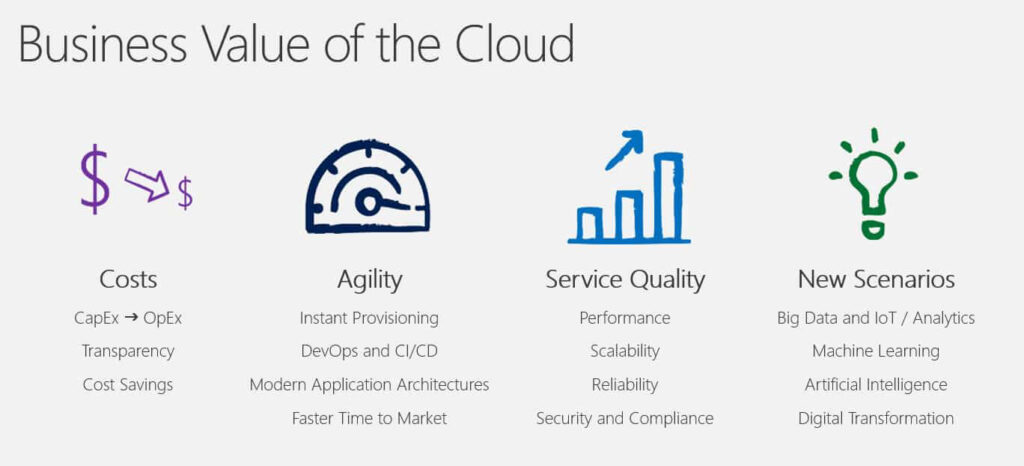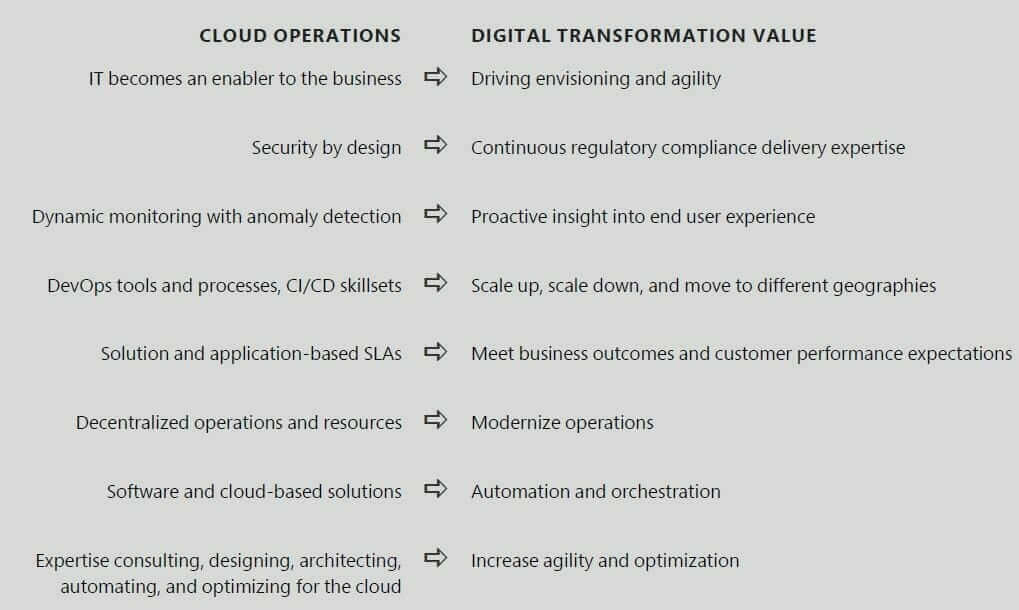The Path to Unprecedented Growth Goes Through the Cloud
It’s time to rethink your processes. There are new ways to embrace the possibilities enabled by modern technologies. We are in a digital-first world. Business leaders, like yourself, need to bring business and IT closer together and optimize processes to create new value for your business and customers.
Digital Transformation is an Executive Mandate
DIGITAL PLATFORMS AND ECOSYSTEMS
By 2020, 60% of all enterprises will have fully articulated an organization-wide digital platform strategy and will be in the process of implementing that strategy as the new IT core for competing in the digital economy.
CLOUD
By 2021, spending on cloud services and cloud-enabling hardware, software, and services will more than double to over $530 billion, leveraging the diversifying cloud environment that is 20% at the edge and over 90% multi-cloud.
HYPER-AGILE APPLICATIONS
By 2021, enterprise apps will shift toward hyper-agile architectures, with 80% of application development on cloud platforms (PaaS) using microservices and cloud functions and over 95% of new microservices deployed in containers.
The Cloud Enables Digital Transformation
It can’t be ignored or brushed aside any longer. Cloud technologies are at the center of the digital transformation revolution. Cloud technology, from Software-as-a-Service to Disaster Recovery, has changed the way businesses implement and manage their IT.
With unparalleled access to data and intelligent new ways to view, analyze and use this information, the cloud has opened powerful new capabilities you only dreamt of. Embrace the cloud with open arms, and your business will see the growth you’ve always wanted.
The Advantages of Implementing the Cloud
Business moving to the cloud do so for a wide range of motivations.
COST
Let’s cut to the chase. Any decision you make is influenced by cost. Cloud is cheaper; Cloud is easier; Cloud is better.
Compared to on-premises infrastructure, the cost-savings are staggering when you consider all the downstream costs of on-premises. You don’t pay for capital expenditures (CapEx) – no electricity, no maintenance, no cooling, no hardware upgrades every few years. Predictable costs for cloud resources provide greater stability and financial flexibility.
AGILITY
Where traditional on-premises infrastructure can take weeks or even months to deploy, Azure offers near-instant provisioning of resources. This enables Azure projects to move much more quickly, without the need to over-provision resources in advance or spend considerable time on infrastructure planning. To take full advantage of this new flexibility, organizations are accelerating the adoption of new ways of working, such as by using agile software development methodologies, continuous integration and deployment (CI/CD), and modern PaaS-based application architectures.
SERVICE QUALITY
Azure’s infrastructure has been designed to support some of the world’s most demanding workloads. These workloads continuously raise the bar on the quality of service Azure must provide. As a result, migration to Azure often offers significant improvements in performance, reliability, and security over on-premises infrastructure.
NEW SCENARIOS
Azure enables new application scenarios which are simply not possible or would be prohibitively expensive to deliver, using on-premises infrastructure, such as big data storage and analytics, machine learning, and compliance with industry certifications such as ISO, PCI, HIPA and GDPR, where customers can leverage the certifications offered by cloud providers. These technologies are enabling new application scenarios, driving innovation and competitive advantages only available in the cloud.

These benefits are all central to a successful digital transformation strategy.
Reduced costs and the shift from CapEx to OpEx dramatically lowers the cost of innovation, enabling a ‘fail-fast’ experimental approach.
This is supported by the increase in agility that lowers innovation costs and enables a faster time-to-market. The scale, performance, reliability, and global reach of the cloud enables small development teams to develop global services for global audiences.
Most of all, new technologies, including big data, IoT, machine learning, and AI empower the insight and customer focus upon which digital transformation depends.
These technologies are often only available in the cloud or are prohibitively expensive on-premises. Moreover, competition between major cloud providers is driving a tidal wave of innovation within the cloud itself. New features and services are added on a weekly or even daily basis, providing an ever-richer platform enabling businesses to continue to experiment, innovate, reduce cost and deliver increasing value.
Embracing the cloud is not simply the easiest or cheapest or fastest way to drive digital transformation—it is the only way. For many businesses, the first step on this journey is to migrate existing applications to the cloud.

Your Cloud Migration Journey
Many businesses will seek help on their cloud migration journey.
As businesses of all sizes embrace digital transformation, traditional on-premises IT becomes increasingly seen as a costly, restrictive, and distracting burden. This creates pressure to reduce or even eliminate on-premises IT by moving existing applications and services to the cloud.
The business-critical nature of many existing applications means any change—especially one as fundamental and far-reaching as cloud migration—represents a business risk. Migration must be as seamless and safe as possible. Cloud migration is a highly technical endeavour and requires skills and experience lacking in traditional IT departments. Recognizing this, many businesses seek outside expertise to help them with their cloud migration journey.
Migrate to the Cloud with Confidence
The Azure Cloud consulting team at 360 Visibility will help your team throughout your journey to the cloud, deploying best practices and ensuring a successful transition.
Use this current slowdown in operations during COVID-19 to assess your infrastructure and make critical improvements to IT, Operations, and Finance and Accounting applications and tools.
Contact 360 Visibility today to begin your journey to the cloud.
ASSESS
The assessment phase is where our team will use a mixture of software tools and consultancy best practices to discover what applications can be migrated, what their current configurations are, the people within the customer organization that will be impacted by the migration, and the dependencies of the application. The assessment’s output will include a comprehensive plan for what to do with the application and the expectations on availability and functionality.
MIGRATE
The migration phase is when the recommendations in the assessment plan are put into place. The following steps are usually taken.
- Setup Azure subscriptions using best practices for security, connectivity, policies and general governance prior to migration to ensure that your company uses Azure correctly from the start.
- Perform the migration using the prescribed method identified in the assessment plan: rehost, retire, replace, rearchitect or retain.
- Evaluate and test to ensure the migrated application meets the criteria outlined in the assessment.
OPTIMIZE
In the optimization phase, we will use Azure security and management resources to govern, secure, and monitor the cloud applications in Azure. This is also the time to look for opportunities to optimize spending. Common tasks at this stage are:
- Review Azure Cost Management and Azure Advisor to track spending and identify areas for cost savings.
- Evaluate migrated applications for opportunities to right-size over-provisioned virtual machines and services.
- Implement automation to resize or stop based on a utilization schedule.
- Identify applications that could benefit from optimization with platform as a service (PaaS) services or containers.
Common Cloud Adoption Concerns
We want to ensure you are prepared and are asking the right questions when adopting the cloud.
Here are the most common concerns and questions that you should ask.
- What are the cost savings / total cost of ownership (TCO) if I move to Azure?
- Which applications should I move – and what is the recommended sequence?
- Will you build my entire environment on Azure, or can part of it remain on-premises/private cloud?
- Will you take care of architecture changes to meet reliability, scalability, and availability requirements?
- What are the impacts on business continuity and my customer relationships?
- Will you ensure that my data and processes comply with regulations?
- Can you show me how you plan to manage and monitor my application in the cloud?
- What are my risks?



